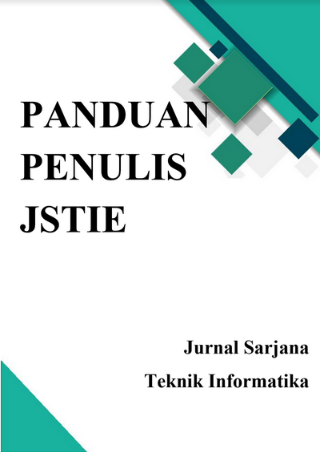Klasifikasi Penyakit Tanaman Padi Berbasis Citra Daun Menggunakan Convolutional Neural Network (CNN)
DOI:
https://doi.org/10.12928/jstie.v12i1.27314Keywords:
CNN, Klasifikasi, Tanaman Padi, VGG16Abstract
Tanaman padi merupakan salah satu tanaman yang berperan penting sebagai makanan pokok yang dikonsumsi dalam kehidupan sehari-hari. Hampir 95% penduduk Indonesia menjadikan beras sebagai makanan pokok, sehingga pada setiap tahunnya permintaan akan kebutuhan beras semakin meningkat seiring dengan bertambahnya jumlah penduduk. Dikarenakan peningkatan kebutuhan dan produksi beras, maka kestabilan produksi beras harus tetap terjaga. Adanya serangan penyakit pada tanaman padi merupakan salah satu faktor yang mempengaruhi kesabilan produksi beras. Kurangnya pengetahuan dan wawasan mengenai penyakit tanaman padi membuat petani kesulitan dalam mengidentifikasi jenis penyakit tanaman padi sehingga memungkinkan pengendalian yang dilakukan kurang sesuai. Hal tersebut dapat menyebabkan tanaman mati dan terjadinya gagal panen. Penelitian ini bertujuan untuk mengetahui hasil akurasi dan mempermudah petani dalam mengklasifikasikan jenis penyakit tanaman padi menggunakan convolutional neural network (CNN) dengan arsitektur VGG16 yang telah dilatih sebelumnya pada dataset ImageNet. Data yang digunakan adalah data empat jenis penyakit tanaman padi yang umum dijumpai yaitu penyakit bacterial leaf blight, penyakit blas, penyakit brown spot dan penyakit tungro. Jumlah data yang digunakan sebanyak 800 data dengan masing-masing 400 data perjenis penyakitnya. Hasil dari penelitian yang dilakukan menunjukkan bahwa CNN menghasilkan akurasi sebesar 88 dan untuk VGG16 memperoleh nilai akurasi sebesar 93. Dapat disimpulkan dari penggunaan dua model tersebut, VGG16 memperoleh akurasi yang lebih tinggi jika dibandingan dengan CNN dalam mengklasifikasikan jenis penyakit tanaman padi berbasis citra daun.References
S. H. Pratiwi, “Growth and Yield of Rice (Oryza sativa L.) on various planting pattern and addition of organic fertilizers,” Gontor AGROTECH Sci. J., vol. 2, no. 2, pp. 1–19, 2016, doi: 10.21111/agrotech.v2i2.410.
C. Wati, “Identifikasi hama tanaman padi (Oriza sativa L) dengan perangkap cahaya di Kampung Desay Distrik Prafi Provinsi Papua Barat,” J. Trit., vol. 8, no. 2, pp. 81–87, 2017, [Online]. Available: https://jurnal.polbangtanmanokwari.ac.id/index.php/jt/article/view/25.
M. Khoiruddin, A. Junaidi, and W. A. Saputra, “Klasifikasi Penyakit Daun Padi Menggunakan Convolutional Neural Network,” J. Dinda Data Sci. Inf. Technol. Data Anal., vol. 2, no. 1, pp. 37–45, 2022, doi: 10.20895/dinda.v2i1.341.
M. R. D. Septian, A. A. A. Paliwang, M. Cahyanti, and E. R. Swedia, “Penyakit Tanaman Apel Dari Citra Daun Dengan Convolutional Neural Network,” Sebatik, vol. 24, no. 2, pp. 207–212, 2020, doi: 10.46984/sebatik.v24i2.1060.
A. J. Rozaqi, A. Sunyoto, and M. rudyanto Arief, “Deteksi Penyakit Pada Daun Kentang Menggunakan Pengolahan Citra dengan Metode Convolutional Neural Network,” Creat. Inf. Technol. J., vol. 8, no. 1, p. 22, 2021, doi: 10.24076/citec.2021v8i1.263.
M. A. Hasan, Y. Riyanto, and D. Riana, “Grape leaf image disease classification using CNN-VGG16 model,” J. Teknol. dan Sist. Komput., vol. 9, no. 4, pp. 218–223, 2021, doi: 10.14710/jtsiskom.2021.14013.
R. Windiawan, A. Suharso, and S. Artikel, “Identifikasi Penyakit pada Daun Kopi Menggunakan Metode Deep Learning VGG16 INFO ARTIKEL ABSTRAK,” Exploreit, vol. 13, no. 2, pp. 9–16, 2019, [Online]. Available: https://doi.org/10.35891/explorit.
R. AGUSTINA, R. MAGDALENA, and N. K. C. PRATIWI, “Klasifikasi Kanker Kulit menggunakan Metode Convolutional Neural Network dengan Arsitektur VGG-16,” ELKOMIKA J. Tek. Energi Elektr. Tek. Telekomun. Tek. Elektron., vol. 10, no. 2, p. 446, 2022, doi: 10.26760/elkomika.v10i2.446.
A. J. Rozaqi, A. Sunyoto, and M. R. Arief, “Implementasi Transfer Learning pada Algoritma Convolutional Neural Network Untuk Identifikasi Penyakit Daun Kentang,” Procedia Eng. Life Sci., vol. 1, no. 1, 2021, [Online]. Available: https://pels.umsida.ac.id/index.php/PELS/article/view/820.
S. Ilahiyah and A. Nilogiri, “ImplementasIlahiyah, S., & Nilogiri, A. (2018). Implementasi Deep Learning Pada Identifikasi Jenis Tumbuhan Berdasarkan Citra Daun Menggunakan Convolutional Neural Network. JUSTINDO (Jurnal Sistem Dan Teknologi Informasi Indonesia), 3(2), 49–56.i Deep Lea,” JUSTINDO (Jurnal Sist. dan Teknol. Inf. Indones., vol. 3, no. 2, pp. 49–56, 2018.
A. E. Nugraha, S. Rizal, and N. K. C. Pratiwi, “Klasifikasi Penyakit Pada Tanaman Singkong Menggunakan Arsitektur VGGNET Berbasis Deep Learning,” e-Proceeding Eng., vol. 8, no. 6, pp. 3240–3246, 2022.
Downloads
Published
Issue
Section
License
License and Copyright Agreement
In submitting the manuscript to the journal, the authors certify that:
- They are authorized by their co-authors to enter into these arrangements.
- The work described has not been formally published before, except in the form of an abstract or as part of a published lecture, review, thesis, or overlay journal. Please also carefully read Journal Posting Your Article Policy.
- The work is not under consideration for publication elsewhere.
- The work has been approved by all the author(s) and by the responsible authorities – tacitly or explicitly – of the institutes where the work has been carried out.
- They secure the right to reproduce any material that has already been published or copyrighted elsewhere.
- They agree to the following license and copyright agreement.
Copyright
Authors who publish with Jurnal Sarjana Teknik Informatika agree to the following terms:
- Authors retain copyright and grant the journal right of first publication with the work simultaneously licensed under a Creative Commons Attribution License (CC BY-SA 4.0) that allows others to share the work with an acknowledgement of the work's authorship and initial publication in this journal.
- Authors are able to enter into separate, additional contractual arrangements for the non-exclusive distribution of the journal's published version of the work (e.g., post it to an institutional repository or publish it in a book), with an acknowledgement of its initial publication in this journal.
- Authors are permitted and encouraged to post their work online (e.g., in institutional repositories or on their website) prior to and during the submission process, as it can lead to productive exchanges, as well as earlier and greater citation of published work.








